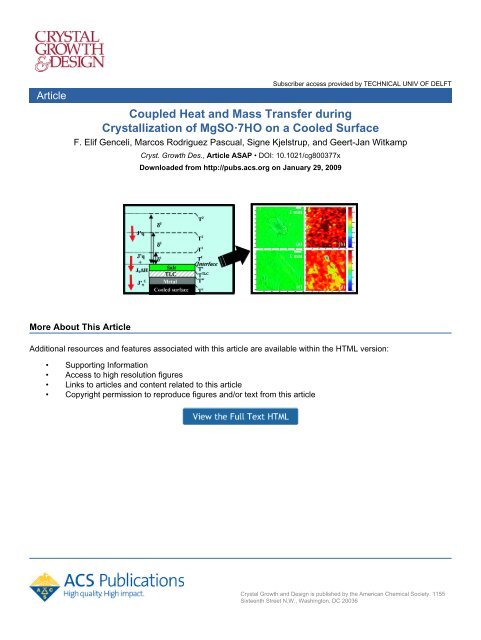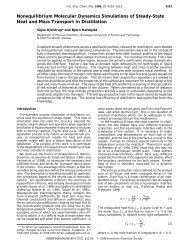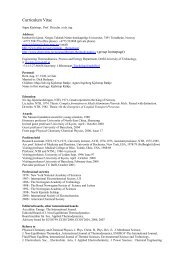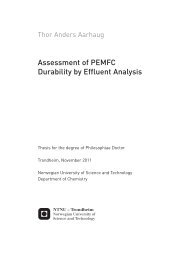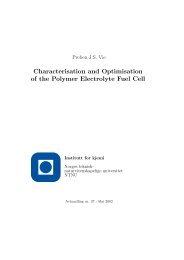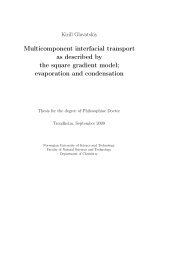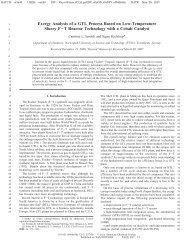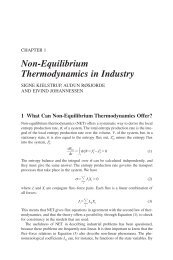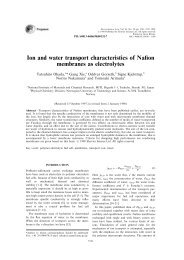Coupled Heat and Mass Transfer during Crystallization of MgSO4 ...
Coupled Heat and Mass Transfer during Crystallization of MgSO4 ...
Coupled Heat and Mass Transfer during Crystallization of MgSO4 ...
Create successful ePaper yourself
Turn your PDF publications into a flip-book with our unique Google optimized e-Paper software.
<strong>Crystallization</strong> <strong>of</strong> MgSO 4 · 7H 2 O on a Cooled Surface Crystal Growth & Design, Vol. xxx, No. xx, XXXX Edifferent approaches all <strong>of</strong> which overlap perfectly well witheach other. These approaches were using the Image J programfor measuring the crystal size changes in time, weighing thecrystal amount at the end <strong>of</strong> the experiment, <strong>and</strong> also doingconcentration measurement in the beginning <strong>and</strong> at the end <strong>of</strong>the experiment <strong>and</strong> extracting the mass flux value from eq 10.The chemical potential difference in eq 15 was calculatedusing Pitzer model. 15 The various equations <strong>and</strong> the constantsneeded in the calculations are presented in the Appendix.Figure 3. Magnified view (figure is not drawn proportional to its origin)<strong>of</strong> the surface <strong>of</strong> Figure 2; k, fraction <strong>of</strong> the enthalpy <strong>of</strong> crystallizationcarried out via the cooled surface, see eq 21.The thickness <strong>of</strong> the salt (δ s ) growing into the liquid direction<strong>and</strong> the mass flux (J) <strong>of</strong> the crystals were estimated using fourResults <strong>and</strong> DiscussionIn Figure 4, single (a) <strong>and</strong> (c) MgSO 4 · 7H 2 O crystal photoson the TLC surface are presented. The transparency property<strong>of</strong> MgSO 4 · 7H 2 O crystals allows us to follow the temperaturepr<strong>of</strong>iles <strong>of</strong> the TLC surface both on crystal-free <strong>and</strong> for thecrystal covered areas. Undistinguished crystal borders on thepost-processing temperature images (b) <strong>and</strong> (d) support this fact.The part <strong>of</strong> the heat (due to heat <strong>of</strong> crystallization) evolved inthe crystal side is transferred both under <strong>and</strong> near the borders<strong>of</strong> the crystal on the TLC.<strong>Crystallization</strong> is a dynamic process in which molecules orions dissolve <strong>and</strong> absorb on the crystal surface simultaneously<strong>during</strong> growth. Therefore warmer or colder temperature readingsunder the crystals compared to the surrounding is possible beforeFigure 4. (a, c) Picture <strong>of</strong> single crystals (labeled 1 to 7) on the TLC surface; (b, d) crystals post-processing temperature images on the TLCsurface; 1 pixel is 65 µm.
H Crystal Growth & Design, Vol. xxx, No. xx, XXXX Genceli et al.N A ′ )-D AB∆C A∆z(24)The force-flux relation in case <strong>of</strong> no heat transport can alsobe simplified from eq 15, <strong>and</strong> mass flux (J) can be defined asa function <strong>of</strong> mass resistivity (R µµ i,s ) <strong>and</strong> chemical potential or,in other words, concentration differences.J )- 1R i,s µµ T l∆ l,s µ T (T l ) )- 1R i,s µµ T lRTl∆ l,s (C)(25)C lEquating eqs 24 <strong>and</strong> 25 <strong>and</strong> knowing that N A ′ ) J, thediffusion coefficient can be written in terms <strong>of</strong> mass resistivityas shown in eq 26.D AB ) ∆zR(26)R i,s µµ C lIf we choose the ∆z value as the interface thickness, 0.3µm (δ i ), <strong>and</strong> use the C l concentration <strong>of</strong> 2.33 mol/m 3 , theD AB is calculated as 8.5 × 10 -10 m 2 /s. This value iscomparable to the diffusion coefficient <strong>of</strong> water-MgSO 4system relation deduced from Gmelin <strong>and</strong> Lobo for the sameconcentration <strong>and</strong> temperature by having the value <strong>of</strong> 8.8 ×10 -10 m 2 s -1 . 11,17,18A similar analogy between conductive heat transfer coefficient(λ) <strong>and</strong> heat resistivity (R qq ) can be derived. Thegeneral heat transfer flux (q′′) relation according to Fourier’slaw is proportional to the temperature (∆T/∆z) gradient inthe direction <strong>of</strong> the heat transfer <strong>and</strong> the thermal conductivitycoefficient (λ). 16q ′′ ) λ ∆ l,s (T)∆z(27)The force-flux relation in case <strong>of</strong> no mass transport canbe simplified from eq 15, <strong>and</strong> the heat flux (J q ′s ) can bedefined as a function <strong>of</strong> heat resistivity (R qq i,s ) <strong>and</strong> temperaturedifference.J ′s q )- 1 ∆ l,s (T)(28)i,sR qq(T l ) 2Equating eqs 27 <strong>and</strong> 28 knowing that q′′ ) J q ′s , the conductionheat transfer coefficient can be written in terms <strong>of</strong> heat resistivityas shown in eq 29.λ )∆z(29)i,s(T l ) 2R qqFor comparison, ∆z, as the interface thickness (δ i ) value, ischosen as 0.3 µm. Using bulk side interface temperature <strong>and</strong>heat resistivity, the thermal conductivity coefficient (λ) iscalculated as 1.5 × 10 -5 Wm -1 K -1 , which is lower than thebulk thermal conductivity value calculated for thewater-MgSO 4 system relation deduced from ref 19 (Melinder)having a value <strong>of</strong> 0.6 W m -1 K -1 . 11,19 By replacing the bulkthermal conductivity value in eq 29, the interface thickness iscalculated to be 12 mm.Mersmann (eq 3.19) 12 assumes the interface temperature tochange within a very small range <strong>and</strong> does not define thetemperature as an independent parameter. Rather, the interfacetemperature <strong>and</strong> concentration were derived from the phasediagram. However, we treat the interface as an open system,where we have heat fluxes in <strong>and</strong> out <strong>of</strong> the system (eq 10).The temperature is then an independent variable.Conclusion<strong>Crystallization</strong> is mostly an exothermic process. According toirreversible thermodynamics, the heat released <strong>during</strong> crystallizationat the interface is distributed to both the liquid <strong>and</strong> the solid phaseswhich are in contact with the interface also for isothermalconditions. We present the temperature jump between the solid<strong>and</strong> the liquid side <strong>of</strong> the interface <strong>and</strong> the heat <strong>of</strong> transfer for bothsides <strong>of</strong> the surface, using MgSO 4 · 7H 2 O crystal growth on a coldsurface as example. For an epsomite crystal growth rate <strong>of</strong> 2.33 ×10 -3 mol m -2 s -1 , around 20-30% <strong>of</strong> the heat <strong>of</strong> crystallizationis calculated to be transferred back into the liquid side. The interfaceresistivity to mass transfer (R µµ i,s ) is 1.26 × 10 3 Jm 2 sK -1 mol -2 ,while the interface resistivity to heat transfer (R qq i,s )is2.1× 10 -7m 2 K -1 W -1 . This is the first time for which the coupling <strong>of</strong> theheat <strong>and</strong> mass transfer equation at the liquid-solid interfacedescription <strong>and</strong> the heat <strong>of</strong> distribution calculation <strong>during</strong> crystallizationis documented.Supporting Information Available: Further details about the PitzerModel. This material is available free <strong>of</strong> charge via the Internet at http://pubs.acs.org.AppendixTable 2. Equations <strong>and</strong> ConstantsconstantsunitCp freezium ) 0.00274T(°C) + 2.818 kJ kg -1 K -1F freezium )-0.4T(°C) + 1289 kg m -3λ<strong>MgSO4</strong>[T aq (°C),C ) wt %]) 5.6 × 10 -1 + 2 × 10 -3 (T) -6.9 × 10 -6 (T) 2 - 6.4 × 10 -4 (C)- 2.3 × 10 6 (C)(T) + 7.8 ×10 -9 (C)(T) 2 Wm -1 K -1<strong>MgSO4</strong> 20 2.427 W m -1 K -1λ saltλ solidλ solid∆H crystmetal+Vaseline ) wall5 W m -1 K -1TLC0.16 W m -1 K -1<strong>MgSO4</strong> 395 J kmol -1C<strong>MgSO4</strong> eq ) 21.3 + 0.206 × T(°C) + wt %0.000833 × T 2 (°C)A cold surface 0.031 m 2δ w 5 mmδ TLC 0.13 mmA cooled 0.0314 m 2F salt 1680 kg m -3(for MgSO 4 · 7H 2 O)measured dataunit <strong>and</strong> sourceT c in 33.572 °C (PT100)T c out 33.579 °C (PT100)T TLC 33.666 °C (photos-without crystal)T 1 33.933 °C (PT100))T 2 34.274 °C (PT100)T 3 34.805 °C (PT100)F coolant 374.60 l h -1δ s 0.35 mmcalculated valuesunitT c log 33.575 °CCp freezium 3.659 kJ kg -1 K -1T TLC without crystal 33.625 °CT s 33.681 °CT l 33.869 °CJ 2.33 × 10 -3 mol m -2 s -1J′ c q 108.20 W m -2J′ q 52.37 W m -2J∆H cryst. 55.83 W m -2′lJ q 31.02 W m -2 (for no mass flux)a w-l 0.937a Mg-l 0.093a SO4-l 0.093a w-s 0.945a Mg-s 0.085a SO4-s 0.085
<strong>Crystallization</strong> <strong>of</strong> MgSO 4 · 7H 2 O on a Cooled Surface Crystal Growth & Design, Vol. xxx, No. xx, XXXX ITable 3. List <strong>of</strong> Captionslist <strong>of</strong> symbolsunita activityC concentration mol m -3Cp specific heat kJ kg -1 K -1D AB diffusion coefficient m 2 s -1∆H cryst. heat <strong>of</strong> crystallization J mol -1h convection heat transfer coefficient W m -2 K -1J mass flux mol m -2 s -1J′ q heat flux J m -2 s -1kenthalpy fraction transferred to thecoolant sideN A ′ convective mass flux mol s -1 m -2R ideal gas constant J K -1 mol -1i,sR qq heat transfer resistivity <strong>of</strong> the surface m 2 s 1 J -1 K -1to the salt sidei,sR µµ mass transfer resistivity <strong>of</strong> the surface JK -1 mol -2 m -2 s -1to the salt sideR i,sqµ ) R qµ coupling film resistivities <strong>of</strong> the m 2 s 1 mol -1 K -1surface to the salt sidei,sR qq heat transfer resistivity <strong>of</strong> the surface m 2 s 1 J -1 K -1to the liquid sidei,sR µµ mass transfer resistivity <strong>of</strong> the surface JK -1 mol -2 m -2 s -1to the liquid sideR i,sqµ ) R qµ coupling film resistivities <strong>of</strong> the m 2 s 1 mol -1 K -1surface to the liquid sideq′′ convective heat flux W m -2q* i,s heat <strong>of</strong> transfer coefficient ratio to the J mol -1salt side <strong>of</strong> the surfaceq* i,l heat <strong>of</strong> transfer coefficient ratio to the J mol -1liquid side <strong>of</strong> the surfaceT temperature °Cz distance from the salt surface mGreek symbolsUnitδ thickness µm, mmλ thermal conductivity W m -1 K -1µ chemical potential J K -1V measured velocity, salt growth rate m s -1F density at the given condition kmol m -3σ entropy production W m -2 K -1cilsTLCsub-superscriptscoolantinterfaceliquidsaltthermo liquid crystalReferences(1) Kjelstrup, S.; Bedeaux, D. Non-equilibrium thermodynamic <strong>of</strong> heterogeneoussystems; Series on Advances in Statistical Mechanics, Vol.16; World Scientific: Singapore, 2008.(2) Bedeaux, D.; Albano, A. M.; Mazur, P. Physica A 1976, 82, 438–462.(3) Bedeaux, D. AdV. Chem. Phys. 1986, 64, 47–109.(4) Albano, A. M.; Bedeaux, D. Physica A 1987, 147, 407–435.(5) Ratje, S. K.; Flesl<strong>and</strong>, O. J. Food Eng. 1995, 25, 553–567.(6) Chen, X. C.; Chen, P.; Free, K. W. J. Food Eng. 1997, 31, 395–402.(7) Badam, V. K.; Kumar, V.; Durst, F.; Danov, K. Experimental <strong>and</strong>theoretical investigations on interfacial temperature jumps <strong>during</strong>evaporation. Exp. Therm. Fluid Sci., 2007, 32(1), 276–292.(8) Kjelstrup Ratkje, S.; Bedeaux, D. J. Electrochem. Soc. 1996, 143 (3),779–789.(9) Gibbs, J. W. The Scientific Papers <strong>of</strong> J.W. Gibbs; Dover: New York,1961.(10) Bedeaux, D.; Kjelstrup, S. Int. J. Thermodyn. 2005, 8 (1), 25–41.(11) Pronk, P. Fluidized bed heat exchangers to prevent fouling in ice slurrysystems <strong>and</strong> industrial crystallizers. PhD Dissertation, Delft University<strong>of</strong> Technology, The Netherl<strong>and</strong>s, 2006.(12) Mersmann, A. <strong>Crystallization</strong> Technology H<strong>and</strong>book, 2nd ed.; MarcelDekker Inc.: New York, 2001.(13) Xu, J.; Kjelstrup, S.; Bedeaux, D.; Røsjorde, A.; Rekvig, L. J. ColloidInterface Sci. 2006, 299, 455–463.(14) Delfos, R.; Lagerwaard, R.; Roos, M. Bottom temperature structurein low-conductivity Rayleigh-Benard convection, EUROTHERM-71 Visualization, Imaging <strong>and</strong> Data Analysis in ConVectiVe <strong>Heat</strong> <strong>and</strong><strong>Mass</strong> <strong>Transfer</strong>, October 28-30, 2002, Reims, France.(15) Pillay, V.; Gaertner, R. S.; Himawan, C.; Seckler, M. M.; Lewis,A. E.; Witkamp, G. J. J. Chem. Eng. Data 2005, 50 (2), 551–555.(16) Incropera, F. P.; De Witt, D. P. Fundamentals <strong>of</strong> <strong>Heat</strong> <strong>and</strong> <strong>Mass</strong><strong>Transfer</strong>, 3rd ed.; John Wiley & Sons: New York, 1990.(17) Gmelins H<strong>and</strong>buch der Anorganschen Chemie, 8th ed.; DeutscheChemische Gesellschaft, Verlag Chemie: Weinheim, 1952.(18) Lobo, V. M. M. H<strong>and</strong>book <strong>of</strong> Electrolyte Solutions.; Elsevier:Amsterdam, 1989.(19) Melinder, Å. Thermophysical Properties <strong>of</strong> Liquid Secondary Refrigerants.Charts <strong>and</strong> Tables.; International Institute <strong>of</strong> Refrigeration: Paris,1997.(20) Thermtest. Thermal conductiVity database <strong>of</strong> materials; http://www.thermtest.com, 2007.CG800377X


